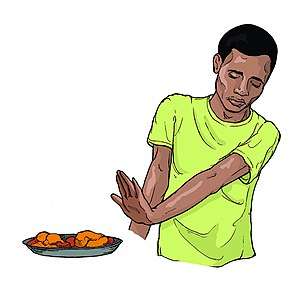Anorexia (symptom)
Anorexia is a decreased appetite. While the term in non-scientific publications is often used interchangeably with anorexia nervosa, many possible causes exist for a decreased appetite, some of which may be harmless, while others indicate a serious clinical condition or pose a significant risk.
| Anorexia | |
|---|---|
 | |
| Specialty | Endocrinology, Psychiatry |
| Symptoms | Loss of appetite |
Anorexia is a symptom, not a diagnosis. When a healthcare provider states that a patient has anorexia, they are simply referring to a decreased appetite. This means that the provider must find and treat the underlying cause of the anorexia. Anorexia is not to be confused with the mental health disorder anorexia nervosa. Because the terms are often used interchangeably, a provider must clarify to a patient to which they are referring as to avoid confusion. Anyone can manifest with anorexia regardless of their gender, age, or weight.
The symptom also occurs in other animals, such as cats,[1][2] dogs,[3][4] cattle, goats, and sheep.[5] In these species, anorexia may be referred to as inappetence. As in humans, loss of appetite can be due to a range of diseases and conditions, as well as environmental and psychological factors.[2][4]
The term is from Ancient Greek: ανορεξία (ἀν-, 'without' + όρεξις, spelled órexis, meaning 'appetite').[6]
Common manifestations
Anorexia simply manifests as a decreased appetite. This can present as not feeling hungry or lacking the desire to eat. Sometimes people do not even notice they lack an appetite until they begin to lose weight from eating less. In other cases, it can be more noticeable, such as when a person becomes nauseated from just the thought of eating. Any form of decreased appetite that leads to changes in the body (such as weight loss or muscle loss) that is not done intentionally as part of dieting is clinically significant.[7]
Physiology of anorexia
Appetite stimulation and suppression is a complex process involving many different parts of the brain and body by the use of various hormones and signals. Appetite is thought to be stimulated by interplay between peripheral signals to the brain (taste, smell, sight, gut hormones) as well as the balance of neurotransmitters and neuropeptides in the hypothalamus.[7] Examples of these signals or hormones include neuropeptide Y, leptin, grehlin, insulin, serotonin, and orexins (also called hypocretins). Anything that causes an imbalance of these signals or hormones can lead to the symptom of anorexia. While it is known that these signals and hormones help control appetite, the complicated mechanisms regarding a pathological increase or decrease in appetite are still being explored.[7]
Common causes
- Acute radiation syndrome
- Acute viral hepatitis
- Addison's disease
- AIDS
- Appendicitis
- Babesia
- Cancer
- Chronic pain
- Chronic kidney disease
- Celiac disease[8]
- Common cold
- Crohn's disease
- Dehydration
- Ebola
- Fever
- Hypervitaminosis D
- Hypermetabolism
- Kidney failure[9]
- Mental disorders, such as depression, bipolar disorder, schizophrenia, Anorexia nervosa, anxiety, dementia, or drug addiction.
- Metabolic disorders, particularly urea cycle disorders
- Pancreatitis
- Stomach flu
- Sickness behavior[10][11]
- Superior mesenteric artery syndrome
- Tuberculosis
- Thalassemia
- Ulcerative colitis
- Zinc deficiency
- Infection : Anorexia of infection is part of the acute phase response (APR) to infection. The APR can be triggered by lipopolysaccharides and peptidoglycans from bacterial cell walls, bacterial DNA, and double-stranded viral RNA, and viral glycoproteins, which can trigger production of a variety of proinflammatory cytokines. These can have an indirect effect on appetite by a number of means, including peripheral afferents from their sites of production in the body, by enhancing production of leptin from fat stores. Inflammatory cytokines can also signal to the central nervous system more directly by specialized transport mechanisms through the blood–brain barrier, via circumventricular organs (which are outside the barrier), or by triggering production of eicosanoids in the endothelial cells of the brain vasculature. Ultimately, the control of appetite by this mechanism is thought to be mediated by the same factors normally controlling appetite, such as neurotransmitters (serotonin, dopamine, histamine, norepinephrine, corticotropin releasing factor, neuropeptide Y, and α-melanocyte-stimulating hormone).[12]
Drugs
- Stimulants, such as ephedrine, amphetamine, methamphetamine, MDMA, cathinone, methylphenidate, nicotine, cocaine, caffeine, etc.
- Narcotics, such as heroin, morphine, codeine, hydrocodone, oxycodone, etc.
- Antidepressants can have anorexia as a side effect, primarily selective serotonin reuptake inhibitors (SSRIs) such as fluoxetine.
- Byetta, a type II diabetes drug, will cause moderate nausea and loss of appetite.
- Abruptly stopping appetite-increasing drugs, such as cannabis and corticosteroids.
- Chemicals that are members of the phenethylamine group. (Individuals with anorexia nervosa may seek them to suppress appetite.)
- Topiramate may cause anorexia as a side effect.
- Other drugs may be used to intentionally cause anorexia in order to help a patient preoperative fasting prior to general anesthesia. It is important to avoid food before surgery to mitigate the risk of pulmonary aspiration, which can be fatal.
Other
- During the post-operative recovery period for a tonsillectomy or adenoidectomy, it is common for adult patients to experience a lack of appetite until their throat significantly heals (usually 10–14 days).[13]
- Altitude sickness
- Significant emotional pain caused by an event (rather than a mental disorder) can cause an individual to temporarily lose all interest in food.
- Psychological stress
- Experiencing grotesque or unappealing thoughts or conversations, or viewing similar images
- Being in the presence of unappealing things such as waste matter, dead organisms, or bad smells
Complications
Complications of anorexia are related to poor oral intake. Poor food intake can lead to dehydration, severe weight loss, electrolyte imbalances, anemia and nutritional deficiencies. These imbalances will worsen the longer that food is avoided.[7]
Sudden cardiac death
Anorexia is a relatively common condition that can lead patients to have dangerous electrolyte imbalances, leading to acquired long QT syndrome which can result in sudden cardiac death. This can develop over a prolonged period of time, and the risk is further heightened when feeding resumes after a period of abstaining from consumption.[14]
Refeeding syndrome
Care must be taken when a patient begins to eat after prolonged starvation to avoid the potentially fatal complications of refeeding syndrome. The initial signs of refeeding syndrome are minimal, but can rapidly progress to death. Thus, the reinitiation of food or oral intake is usually started slowly and requires close observation under supervision by trained healthcare professionals. This is usually done in a hospital or nutritional rehabilitation center. [14]
Management
Anorexia can be treated with the help of orexigenic drugs.
"Anorexia" vs "anorexic" vs anorexia nervosa

Anorexia is a medical symptom defined as a decreased appetite.
Anorexic is a description of somebody with the stereotypical thin, frail, malnourished appearance. The appearance is classically associated with anorexia, although in rare cases do patients end up becoming anorexic. An anorexic or anorectic is also a description given to substances that cause anorexia for weight loss purposes.
Anorexia nervosa is an eating disorder characterized by food restriction due to the strong desire to remain thin. It is considered a mental health diagnosis where people see themselves as overweight regardless of their weight or appearance.[15] The person does not necessarily exhibit anorexia as a symptom in their quest to restrict food intake.[15]
References
- Chan, Daniel L. (November 1, 2009). "The Inappetent Hospitalised Cat: Clinical Approach to Maximising Nutritional Support". Journal of Feline Medicine and Surgery. 11 (11): 925–933. doi:10.1016/j.jfms.2009.09.013.
- "Anorexia". Cornell Feline Health Center. Cornell University. Retrieved July 19, 2020.
- Carrozza, Amanda; Marks, Stanley (November 20, 2018). "NY Vet: The Best Approach to Treating Inappetence". American Veterinarian. Archived from the original on July 19, 2020. Retrieved July 19, 2020.
- Llera, Ryan; Downing, Robin. "Anorexia in Dogs". VCA Animal Hospital. Archived from the original on July 19, 2020. Retrieved July 19, 2020.
- Jubb, Tristan; Perkins, Nigel. "Inappetence/Inanition". Veterinary Handbook for the Livestock Export Industry. Australian Livestock Export Corporation, Meat & Livestock Australia. Archived from the original on July 19, 2020. Retrieved July 19, 2020.
- Psyhogeos, Matina (14 April 2016). Page Publishing Inc. (ed.). English Words Deriving from the Greek Language. ISBN 978-1682134283.
- Jameson, Larry (2016). Endocrinology: Adult and Pediatric. Philadelphia, PA: Saunders. pp. 506–510. ISBN 978-0-323-18907-1.
- Taylor AK, Lebwohl B, Snyder CL, Green PHR (17 September 2015). "Celiac Disease". GeneReviews®. Retrieved 24 September 2017.
- "Pinworms in Kids & Adults: Pictures, Symptoms & Treatments Viewer Comments and Reviews: Hypothyroidism - Symptoms - Patients Share Their Knowledge on eMedicineHealth". eMedicineHealth. Retrieved 2017-11-28.
- Exton, M. S. (1997). "Infection-Induced Anorexia: Active Host Defence Strategy". Appetite. 2 (3): 369–383. doi:10.1006/appe.1997.0116. PMID 9468766.
- Murray, M. J.; Murray, A. B. (1979). "Anorexia of infection as a mechanism of host defense". The American Journal of Clinical Nutrition. 32 (3): 593–596. doi:10.1093/ajcn/32.3.593. PMID 283688.
- Langhans W. (October 2000). "Anorexia of infection: current prospects". Nutrition. 16 (10): 996–1005. doi:10.1016/s0899-9007(00)00421-4. PMID 11054606.
- "Home Care After Tonsillectomy and Adenoidectomy". Archived from the original on December 12, 2013.
- Jáuregui-Garrido, B.; Jáuregui-Lobera, I. (2012). "Sudden death in eating disorders". Vascular Health and Risk Management. 8: 91–98. doi:10.2147/VHRM.S28652. PMC 3292410. PMID 22393299.
- "NIMH » Eating Disorders". www.nimh.nih.gov. Retrieved 2019-12-02.
External links
| Classification | |
|---|---|
| External resources |